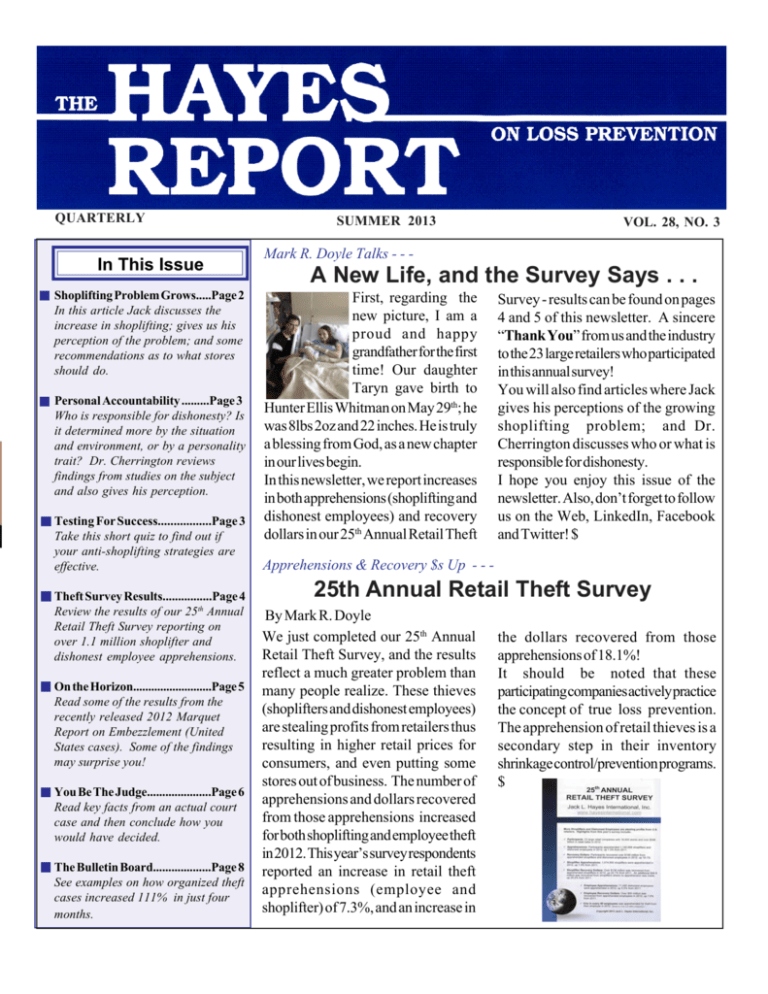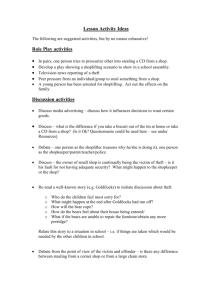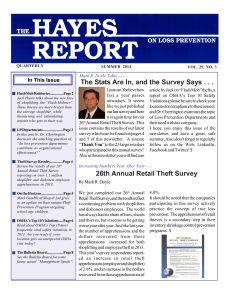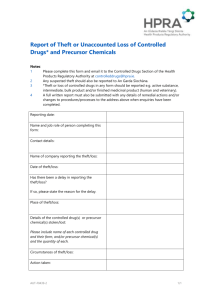
QUARTERLY
In This Issue
Shoplifting Problem Grows.....Page 2
In this article Jack discusses the
increase in shoplifting; gives us his
perception of the problem; and some
recommendations as to what stores
should do.
Personal Accountability .........Page 3
Who is responsible for dishonesty? Is
it determined more by the situation
and environment, or by a personality
trait? Dr. Cherrington reviews
findings from studies on the subject
and also gives his perception.
Testing For Success.................Page 3
Take this short quiz to find out if
your anti-shoplifting strategies are
effective.
Theft Survey Results................Page 4
Review the results of our 25th Annual
Retail Theft Survey reporting on
over 1.1 million shoplifter and
dishonest employee apprehensions.
On the Horizon..........................Page 5
Read some of the results from the
recently released 2012 Marquet
Report on Embezzlement (United
States cases). Some of the findings
may surprise you!
You Be The Judge.....................Page 6
Read key facts from an actual court
case and then conclude how you
would have decided.
The Bulletin Board...................Page 8
See examples on how organized theft
cases increased 111% in just four
months.
SUMMER 2013
VOL. 28, NO. 3
Mark R. Doyle Talks - - -
A New Life, and the Survey Says . . .
First, regarding the
new picture, I am a
proud and happy
grandfather for the first
time! Our daughter
Taryn gave birth to
Hunter Ellis Whitman on May 29th; he
was 8lbs 2oz and 22 inches. He is truly
a blessing from God, as a new chapter
in our lives begin.
In this newsletter, we report increases
in both apprehensions (shoplifting and
dishonest employees) and recovery
dollars in our 25th Annual Retail Theft
Survey - results can be found on pages
4 and 5 of this newsletter. A sincere
“Thank You” from us and the industry
to the 23 large retailers who participated
in this annual survey!
You will also find articles where Jack
gives his perceptions of the growing
shoplifting problem; and Dr.
Cherrington discusses who or what is
responsible for dishonesty.
I hope you enjoy this issue of the
newsletter. Also, don’t forget to follow
us on the Web, LinkedIn, Facebook
and Twitter! $
Apprehensions & Recovery $s Up - - -
25th Annual Retail Theft Survey
By Mark R. Doyle
We just completed our 25th Annual
Retail Theft Survey, and the results
reflect a much greater problem than
many people realize. These thieves
(shoplifters and dishonest employees)
are stealing profits from retailers thus
resulting in higher retail prices for
consumers, and even putting some
stores out of business. The number of
apprehensions and dollars recovered
from those apprehensions increased
for both shoplifting and employee theft
in 2012. This year’s survey respondents
reported an increase in retail theft
apprehensions (employee and
shoplifter) of 7.3%, and an increase in
the dollars recovered from those
apprehensions of 18.1%!
It should be noted that these
participating companies actively practice
the concept of true loss prevention.
The apprehension of retail thieves is a
secondary step in their inventory
shrinkage control/prevention programs.
$
HAYES REPORT * LOSS PREVENTION * HAYES REPORT * LOSS PREVENTION
"Mind Boggling" Statistics - - -
Did You Know
Shoplifting Problem Grows
By Jack L. Hayes
A worldwide gang of criminals
stole $45 million in a matter of
hours by hacking a database of
prepaid debit cards and draining
cash machines around the globe.
Retail News You Can Use
Transportation incidents result in
1,857 work-related deaths annually.
Injury Fact 2013 Edition
Based on an analysis of more than
3.4 million urine and 340,000 oral
drug tests, job applicants taking a
pre-employment drug screen tested positive for illegal drugs at a
5.7% higher rate during the first
half of 2012 than all of 2011.
Quest Diagnostics Drug Test Index
Retailers’ revenue lost to online
fraud has increased over the past
two years and reached an estimated
$3.5 billion in 2012, up 3% from
2011 and up 30% from 2010.
2013 Online Fraud Report
Larceny occurs most often:
• From vehicles
•Shoplifting
• From buildings
• Purse snatching
• Pick pockets
US Census Bureau
A study found that inspected
workplaces saved an average of
$355,000 on injury claims and losttime compensation without harming
profits.
Science (Vol 336, No 6083)
Page 2
This year’s survey statistics are
certainly ones that every retailer should
give special attention. Shoplifter
apprehensions are up over seven
percent (7.4%), and dollar recoveries
from those apprehensions up over
twenty-two percent (22.7%). A sure
sign that the shoplifter problem is not
only getting worse, these thieves are
stealing more! Of particular concern is
the fact that the greater majority of our
participating companies truly practice
theft preventative strategies and utilize
state-of-the-art technology. Yet,
shoplifters just keep coming! Sure,
we all know that organized rings are a
most serious problem, such as that
group of eight who were recently
apprehended in Florida and charged
with stealing and reselling nearly
$100,000 in merchandise taken from
drug stores and supermarkets.
We also can’t ignore amateurs such
as those three teenagers who were
recently caught using a 12 day-old
baby to help conceal goods in a car
seat under the infant. Nor can we
overlook others like the mother and
daughter caught shoplifting in a
department store, or the justice of the
peace caught on camera. Then there
are those who make national news,
such as reports of shoplifting allegations against the mother of those two
alleged Boston bombing suspects—
this list could go on and on. Bottomline, there simply is no profile to help
you identify your potential shoplifter!
Keep in mind, that those shoplifters in
our survey, and those reported by the
media are the ones that were actually
caught. How many shoplifters are
actually identified? Could the answer
be one in 10, 24, 50, or even higher?
No one knows the answer to this
difficult question. However, my
decades of experience teaches me that
using a twenty-to-one ratio is a
conservative estimate.
If you think shoplifting is not a problem
in your store – think again! These
thieves are everywhere, and come from
every background imaginable. Here’s
my perception of the problem:
> Decline in Honesty: Today, it’s difficult to listen to a news report, or pick
up a newspaper without being made
aware of some act of dishonesty being
discovered in government, business,
sports, or religious organizations.
Today, our culture is getting more and
more permissive—those disgraceful
acts mentioned above, as well as such
“trivial” crimes as shoplifting are no
longer viewed as a humiliating or
embarrassing situation.
> Poor Economy: Staff cutbacks in
retail stores have all but destroyed one
of the retailer’s most effective
deterrents—customer service.
> Drug Problems: Shoplifting is a
favorite way for addicts to support
their habit.
> Smarter Hardcore Thieves: Groups
of brazen thieves simply ignore, or go
to great extents to defeat state-of-theart anti-theft equipment.
> Legal factors are also playing a role
in the elevation of this crime. For
example, it is well known that the lack
of serious consequences in the justice
system does little to discourage
Continued on Page 7
THE HAYES REPORT
HAYES REPORT * LOSS PREVENTION * HAYES REPORT * LOSS PREVENTION
Personality Trait or Situation - - -
Personal Accountability for Dishonesty
By Dr. David J. Cherrington
Last week I listened to a research
report from one of my colleagues in
information technology who conducted
a fascinating study about theft in the
restaurant industry. This study identified five common methods that servers
use to steal from customers, such as
double charging for drinks. However,
advances in information technology
make it possible to detect patterns of
dishonesty, and when they are detected
employees can be observed more closely
and confronted with their dishonesty.
After employees learned that their
dishonesty could be detected, incidents
of stealing declined by about seventy
percent. This study concluded that
employee theft represents a
pathology of the organization rather
than a pathology of the employees
since companies could install internal
control systems that are highly effective
in detecting dishonesty. In short,
inadequate control systems are more
responsible for theft than dishonest
employees.
The idea that dishonesty is determined
more by the situation than by a
personality trait has been around for a
long time. In a series of studies on
honesty from 1924 to 1928, Hugh
Hartshorne and Mark May examined
the behavior of 7000 children from 816 years of age. The children
participated in about a dozen games
that allowed observers to test their
honesty. For example, in the planteddime test each child was given a box
containing various contents, including a
dime which was supposed to be used in
one of the puzzles. After the boxes
SUMMER 2013
were returned, the researchers
checked to see if the dime had been
stolen.
Hartshorne and May concluded that
honesty is not a stable personal attribute; rather, it is determined by the
situation—being honest in one situation
was no indication that the same child
would be honest in another situation.
Their conclusion had a huge impact on
subsequent thinking about personal
accountability for one’s behavior.
Shoplifting, embezzlement, and violence were attributed to dysfunctional
environments such as poverty, broken
homes, and bad neighborhoods.
Later research that examined
Hartshorne and May’s data in greater
depth found that their conclusions were
not universally true; a small percent of
the children demonstrated a general
trait of honesty. These children generally
came from homes where honesty had
been taught as a general standard and
where it had been consistently
demonstrated and rewarded.
In the field of psychology, B. F. Skinner
is recognized as one of the leading
scholars to espouse the concept of
environmental determinism. This
concept claims that behavior is
determined not by personality traits or
free will but by environmental factors,
especially the rewards and punishments
associated with the behavior. Skinner
illustrated the power of his ideas in a
novel, Walden Two, which explained
how a community could structure its
social rewards to create a utopian
Continued on Page 6
Testing
For Success
As the results of our 25th
Annual Retail Theft Survey
reflect, shoplifting continues to
plague the retail industry. Take our
short quiz to find out if your antishoplifting strategies are effective.
1. Are your anti-shoplifting
safeguards equal to or greater than
your competitions?
Yes No
2. Are all store associates taught
that effective customer service is
the #1 deterrent to shoplifting?
Yes No
3. Have all store associates been
adequately trained in preventing
shoplifting, AND is this training
being followed?
Yes No
4. Do you have good sight lines on
the sales floor to easily view high
value and highly popular items (no
blind spots)?
Yes No
5. Are high value/highly pilferable
items displayed on the sales floor
adequately protected? Yes No
6. If you use EAS, are required
items consistently tagged at or above
the 98% level? (Check 200 pcs)
Yes No
7. If you have fitting rooms, are
they kept locked or being consistently monitored? Yes No
If you answered “NO” to one or
more of the above seven questions, your store may be an “easy
mark” for shoplifters. Act now to
correct your vulnerabilities! $
Page 3
HAYES REPORT * LOSS PREVENTION * HAYES REPORT * LOSS PREVENTION
Believe It or Not
SURVEY PARTICIPANTS
• 23 Large Retail Companies
• 18,900 Stores (representing an excellent cross-section of the U.S.)
• $596,396,845,808 in Annual Retail Sales (2012)
I guess thieves will steal about
anything when they are hungry
or thirsty!
The following food and beverage
thefts have been recently reported in
the press:
- Thin Mints: A truck driver in South
Carolina stole $19,000 worth of Girl
Scout Thin Mint cookies from a
warehouse.
- Maple Syrup: Four men swiped
16 million barrels of maple syrup in
Quebec, worth approximately $18
million.
TOTAL RETAIL THEFT APPREHENSIONS
Difference
2011
2012
#/$
Pct.
Apprehensions 1,067,514
Recoveries
1,145,688
78,174
7.32%
$160,585,722 $189,601,438 $29,015,716
Avg. Case Value $150.43
$165.49
$15.06
18.07%
10.01%
Retail Theft Apprehensions Breakdown
SHOPLIFTING
2011
2012
#/$
1,074,593
74,442
- Soup: A Florida man stolen a tractor trailer containing $75,000 worth
of Campbell’s soup.
Apprehensions 1,000,151
- Nutella: Thieves stolen 5.5 tons of
jarred Nutella valued at $20,710
from a parked trailer in a lot.
Avg. Case Value $113.05
$129.12
Hours Per Appreh.* 62.39
51.84
Recoveries
Difference
Pct.
7.44%
$113,066,629 $138,751,524 $25,684,895
$16.07
22.72%
14.22%
-16.91%
(*10 companies reporting)
- Red Bull: An undetermined amount
of Red Bull was stolen from a trailer
in a parking lot.
Recoveries
$37,389,343 $46,811,021
- Coffee: $40,00 worth of coffee
was stolen from a trailer in a parking
lot.
25.20%
DISHONEST EMPLOYEES
2011
- Raw Beef: Florida thieves stole a
full truck of raw beef from a parking
lot with a value of $250,000.
Apprehensions 67,363
- Chicken Wings: Two Georgia
men were arrested for stealing
$65,000 in chicken wings. $
Avg. Case Value $705.42
Page 4
$9,421,678
(No Apprehension Made)
Recoveries
$47,519,093
Difference
Pct.
2012
#/$
71,095
3,732
5.54%
$50,849,914
$3,330,821
7.01%
$715.24
$9.82
1.39%
THE HAYES REPORT
HAYES REPORT * LOSS PREVENTION * HAYES REPORT * LOSS PREVENTION
HIGHLIGHTS FROM JACK L. HAYES INTERNATIONAL’S
25TH ANNUAL RETAIL THEFT SURVEY
TOTAL RETAIL THEFT
Survey participants apprehended a total of 1,145,688 dishonest individuals
(shoplifters and employees) in 2012, an increase of 7.3% from the prior year.
In addition, dollars recovered from those apprehensions totaled over $189
million, which was an 18.1% increase from 2011.
For every $1.00 recovered by our surveyed companies, $25.00 was lost to
retail theft. Therefore, only 4.0% of total retail theft losses resulted in a
recovery.
SHOPLIFTING
Apprehensions: Survey participants apprehended 1,074,593 shoplifters in
2012, an increase of 7.4% from the prior year.
Recoveries: Dollars recovered from shoplifting apprehensions totaled over
$138 million in 2012, a substantial 22.7% increase from 2011.
Case Value: The average shoplifting case value in 2012 was $129.12, which
was an increase of 14.2% from 2011’s average case.
For the 16th consecutive year, dollars recovered from shoplifters where no
apprehension was made (over $46 million) increased. In 2012, this increase
was an amazing 25.2%.
On The Horizon
Results from the recently released
2012
Marquet Report on
Embezzlement reveals the highest
rate of employee theft in five years.
This annual study reports on 528
major embezzlement cases in the
U.S. in 2012, all with reported losses
in excess of $100,000. Some of the
highlighted findings include:
- Major embezzlements increased
11% over 2011.
- Average loss was approximately
$1.4 million.
- Major embezzlement schemes on
average span nearly a 5 year period.
- 58% of all incidents in 2012 involved
female perpetrators.
- Less than 5% of major embezzlers
have a prior criminal record.
- Most common embezzlement
scheme is the forgery of unauthorized
issuance of company checks.
- Financial institutions followed by
non-profits had the highest frequency
of embezzlements.
* * * * * *
*
Upcoming Conference
• The National Food Service Security
EMPLOYEE THEFT
Apprehensions: Survey participants apprehended 71,095 dishonest
employees in 2012, an increase of 5.5% from the prior year.
Recoveries: Dollars recovered from dishonest employee apprehensions
totaled over $50 million in 2012, a 7.0% increase from 2010.
Case Value: The average dishonest employee case value in 2012 was
$715.24, a 1.4% increase from 2011’s average case value.
One out of every 40.0 employees was apprehended for theft from their
employer in 2012. (Based on comparison data of over 2.8 million
employees.)
SUMMER 2013
Council’s 34th Annual Conference
will be held August 4-7, 2013 at the M
Resort Spa and Casino in Las Vegas,
NV. For additional information visit:
www.nfssc.com
• ASIS International’s 59th Annual
Seminar and Exhibits is blowing into
Chicago on Sept 24-27, 2013 at
McCormick Place. For additional
information visit: www.asis2013.org
• “Leading Safety into the Future” is
the theme of this year’s 2013 National
Safety Council Congress & Expo
taking place at McCormick Place in
Chicago, IL from Sept 28 thru Oct 4,
2013. For additional information visit:
www.congress.nsc.org
Page 5
HAYES REPORT * LOSS PREVENTION * HAYES REPORT * LOSS PREVENTION
Continued from Page 3
Personal Accountability for Dishonesty
You Be The Judge
Here are key facts from an actual
court case. How would you have
decided?
A loss prevention officer working for a
grocery chain observed a man pick-up
several bottles of shampoo and place
them into a reusable shopping bag. The
officer thought this was a bit strange
because the man was bald and the
shampoo was rather expensive. He
then watched the man take other articles
and place them into his bag. Upon
exiting the store with the reusable bag,
the officer stopped the man. The man
was cooperative, reentered the store
with the officer and proceeded to admit
to taking the goods to trade them for
drugs. The police arrived, read the
man his Miranda rights and the man
agreed to discuss the situation with the
police. He admitted to the thefts and
was taken to the police department.
After a two-day trial, the man was
found guilty of shoplifting with an
“artifice, instrument, container, device
or other article”, and for organized
retail theft. He received two 10 year
sentences and was ordered to pay
restitution to the store.
The man appealed his conviction and
sentence on multiple grounds including:
Lack of producing the actual items
stolen; Lack of preliminary hearing;
Using prior convictions to determine
sentencing; and violations of his
constitutional rights.
What’s your verdict?
You will find the court’s decision on
the back page.
Page 6
planned society. These ideas have
been developed by therapists and
teachers and form the foundation of a
change intervention called applied
behavioral analysis.
The idea that the situation surrounding
us will have an enormous influence on
how we behave has become
increasingly recognized throughout
the behavioral sciences. Many studies
have demonstrated that personality
traits, such as honesty, altruism, and
kindness, have a much smaller influence on how we act than the forces in
the particular situation. Indeed,
numerous studies have found that the
maximum correlation is about .30
between a measured personality trait
and manifestations of that behavior in
a given setting. In social psychology,
this is called the predictability ceiling.
The enormous influence of the
environment on our behavior is not
quite so surprising when we think more
carefully about it. For example, even
people who are kind and patient will
eventually push back if they are
continually mistreated and pushed
enough. Likewise, the fraud model
suggests that even extremely honest
people will eventually succumb to fraud
if they leave themselves in situations
where they face intense situational
pressures and have convenient
opportunities to steal.
The crucial question is how our concept
of personal accountability squares
with research showing the impact of
the environment. Is the concept of
moral agency still a viable concept? If
the situation has such an enormous
influence on our behavior, are we still
responsible for our actions? Our focus
on situational influences seems to be
eroding the idea that people are moral
agents who are liable for what they do.
The concept of personal accountability
declares that people are responsible
for what they do. It does not deny the
possibility that situational forces
surround us and entice us to behave
contrary to what we think we should
do. Indeed, the presence of competing
interests is essential for the concept of
moral agency to be a meaningful
concept.
Our legal system holds people
accountable for their actions; when
thieves are caught stealing, they are
convicted and punished for their
crimes regardless of the environments
from which they come. As a general
rule, we do not punish a criminal’s
family, friends, teachers, or ministers
for failing to create a healthy
environment. In only very limited cases
have judges imposed punishments on
parents when their children have
committed serious crimes.
When I am faced with a moral choice
between right and wrong, am I really
free to choose what is right regardless
of the social or economic consequences
of my choice? My answer is yes. If my
family, friends, and society are
encouraging me to do what I know is
wrong, am I still free to choose what is
right? Again, my response is yes. And
is it possible for me to reform my life
and follow a different path even if I
have a history of making bad choices
because of previous moral weaknesses
that have formed addictive behaviors?
It may be extremely difficult, but
again, the answer is yes. Ultimately, I
am free to decide and I am accountable for my actions. $
THE HAYES REPORT
HAYES REPORT * LOSS PREVENTION * HAYES REPORT * LOSS PREVENTION
Continued from Page 2
Shoplifting Problem Grows
THE HAYES REPORT
shoplifting—most shoplifters do not
go to jail. Repeat shoplifters are given
probation, or a “slap-on-the-wrist”,
which is due to lenient state laws, and/
or jail overcrowdings. More and
more states are issuing citations to
misdemeanor shoplifters, further
minimizing the severity of this crime in
the offender’s eyes. Last, but certainly
not least, various states have raised
their felony theft thresholds (i.e. to as
much as $2,000) before the suspect
can be charged with a felony.
Hardcore thieves know which states
have severe laws and they mostly
prey on those that do not. (These
thieves also target stores known not
to prosecute.)
So, what is one to do? Again, my
perception:
1. Shoplifters, be they professional,
hardcore, or amateur, want and need
privacy to commit their act. Customer
service is STILL the most effective
deterrent to shoplifting.
2. Keep your staff alert to the severity
of this crime, and provide brief antitheft pointers at each meeting—better
yet, a daily brief reminder can do no
wrong. If theft prevention is a priority
to you, it will also be a priority to your
staff.
3. Talk with local police and find out
what type of problems are happening
in close proximity to your store. See
what tips or assistance the police will
provide. For example, Rochester
New Hampshire police have in place a
website that enables retailers to share
information on shoplifting incidents at
their establishments. For information,
contact Tracy Hayes (no relation) at
Tracy.Hayes@rochesterh.net
4. If your location is equipped with
anti-theft equipment, make sure it is
working properly, merchandise tagged
that should be protected, and your
staff is well versed in what action they
are to take when a security system
sends an alert. $
Shoplifter Goes to Jail and
Gets Arrested!
Two women were observed shoplifting in several stores in
a Connecticut outlet center. The police were called and
after reviewing video from one of the stores they arrested
two women and charged them both with two counts of
sixth-degree larceny. Bond was set at $1,500 each. When
a woman came to the Police Department to bond out her two shoplifting friends,
the police also recognized her from the store video they had viewed and
proceeded to arrest and charge her with one count of sixth-degree larceny. $
SUMMER 2013
ADVISORY BOARD
Jack L. Hayes
Internationally recognized expert on
Asset Protection who has consulted
for some of the finest retail companies
world-wide over his 40 years in the
industry. Producers of several award
winning LP training programs and
author of the book, “Business Fraud:
From Trust to Betrayal”.
David J. Cherrington
Professor of Organizational Leadership
and Strategy at BYU; certified SPHR,
and recognized authority on employee
dishonesty and white collar crime.
Edmund Di Marco
Retail career extends over the course
of 30 years in Asset Management, and
currently operates a Risk Management
consulting firm.
The Hayes Report is published
quarterly by Jack L. Hayes
International, Inc., 27520 Water Ash
Drive-Suite 100, Wesley Chapel, FL
33544. Telephone (813) 991-5628
Copyright 2013. All rights reserved,
including the right to reproduce in whole
or in part. Publication's intent is to
provide general information with regard
to subject matter. Accuracy is not
guaranteed, and no further
representation is made.
Design and layout by Cathy A. Doyle.
Single Subscriptions: $50 per year.
Multiple Subscriptions: Start at just
10 subscriptions mailed to the same
address for just $100 per year.
Canadian Subscribers: Add $3 per
subscription, per year.
Overseas Subscribers: Add $8 per
subscription, per year.
Payable in U.S. Funds drawn on U.S.
Banks.
Page 7
HAYES REPORT * LOSS PREVENTION * HAYES REPORT * LOSS PREVENTION
The Bulletin Board
Jack L. Hayes International is
recognized as the foremost loss
prevention/inventory shrinkage
control and safety consulting firm in
the world. They offer a variety of
related services and products utilized
by hundreds of the finest retail,
manufacturing and industrial
organizations throughout the world.
Consulting Services & Products:
Shrink Control Analyses and
Assessments
Safety & OSHA Compliance
Analyses and Assessments
3rd Party Store & Warehouse/
DC LP and Safety Audits.
Custom Designed and Implemented LP & Safety Programs and
Audits
Risk Management Services
Safety Committee Formation &
Consultation
“The Hayes Report” on Loss
Prevention Newsletter (quarterly)
Pre-employment Screening
For additional information on Jack L.
Hayes International's loss prevention/
shrinkage control and safety services,
including consulting and 3rd party audits,
visit our redesigned website at:
http://www.hayesinternational.com
You can e-mail Mark R. Doyle at:
mrd@hayesinternational.com
Publicly reported Organized Retail
Theft cases increase 111% in first 4
months of 2013 vs 2012.
Here are a Few Examples:
San Francisco police bust a big shoplifting ring dealing in everyday
items which could be easily sold (ie. shampoo, conditioner, razor
blades, batteries and the like). Total value in the $300,000 to
$400,000 range.
Polk County Florida sheriffs arrest 16 and seek two others in a
large-scale retail theft ring involving mostly apparel/clothing. Items
were sold or returned for gift cards and then the gift cards sold.
Total value is estimated in the $6 to $7 million range.
Man accused of stealing more than $600,000 from mass merchant
in the Carolinas and Georgia. The man returned counterfeit DVDs
and software, mis-priced sporting goods and used pre-paid gift
cards and doctored receipts in his fraudulent returns.
Two men facing federal charges for retail fraud operation in home
centers in 13 states. The men are accused of switching UPC
codes on expensive items with UPC codes from much cheaper
items, using self-checkouts whenever possible. The items were
then returned for store credit for the much higher amount. Total
value is estimated at over $300,000.
Share your favorite ‘Bulletin Board’ items. Submissions for
“The Bulletin Board” should be addressed to:
The Hayes Report
27520 Water Ash Drive - Suite 100
Wesley Chapel, FL 33544
or emailed to: operations@hayesinternational.com
_______________________________________________________________________
Verdict.........
Or visit us on the Social Media
http://www.facebook.com/
JackLHayesInternational
http://www.linkedin.com/
company/2591308?trk=tyah
https://twitter.com/
#!/JackLHayesInter
Page 8
After careful review of the record, the court found no meritorious grounds for
reversal of the conviction or modification of the sentences imposed. The court
noted that the evidence supported the verdict, the sentence imposed was within
sentencing limits, and the man was appropriately represented at all stages of the
proceedings. $
CA-CR 11-0290-1
THE HAYES REPORT











